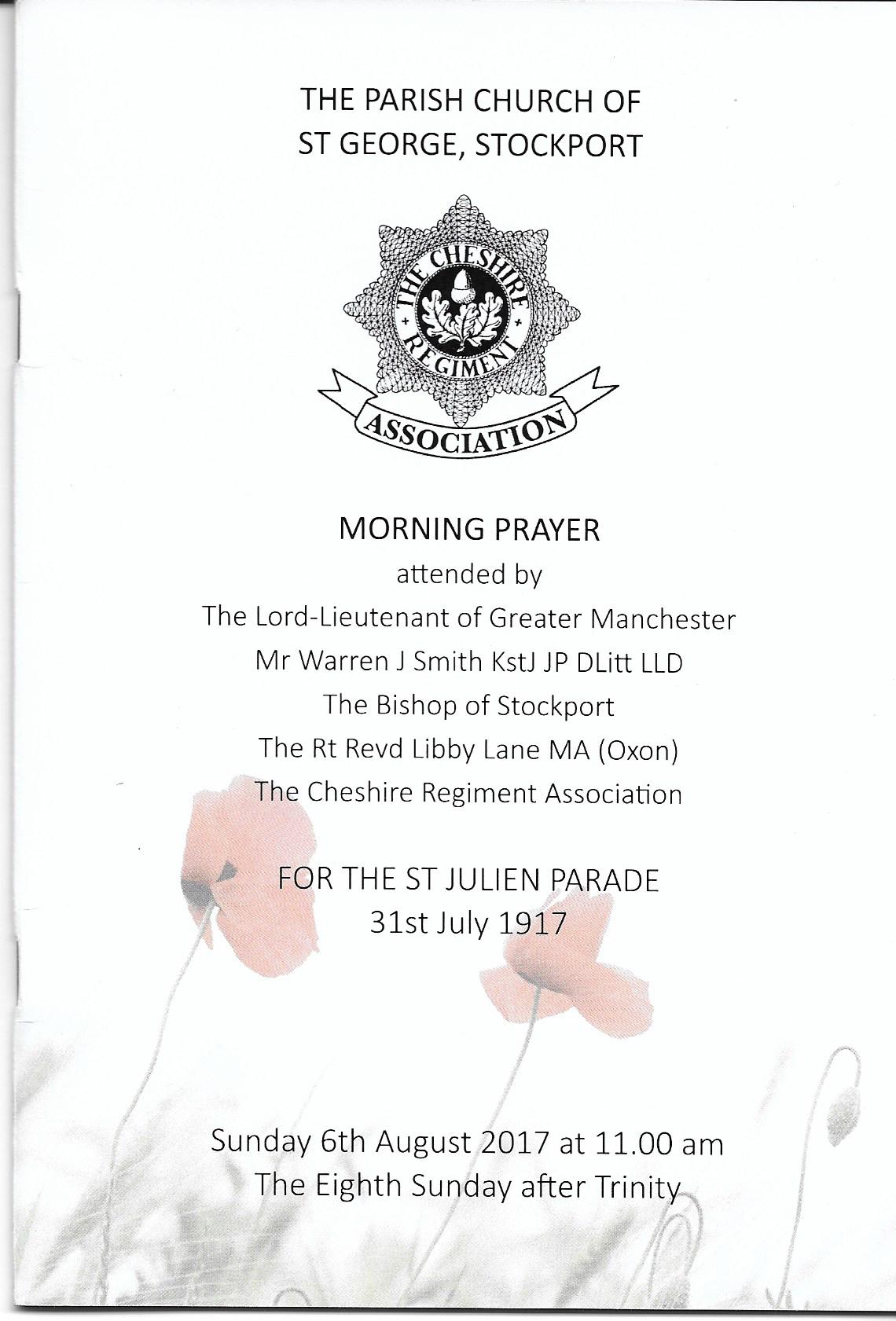Newsletters
- Details
- Category: Newsletters
The newsletters for 2018 are in this section.
- Details
- Category: Newsletters
Chairman’s Notes
Good Evening and welcome to our first event of the New Year. I trust you have all recovered from the effects of the Festive Season. Ann and I enjoyed our trip to Ypres (See my article). We were surprised to see that Branch member Arthur Wood was also staying there.
Terry Jackson. Chairman
Chairman’s Visit to Ypres
My birthday is one week before Christmas and this year I will have become a septuagenarian. A hundred years ago in late July, 6 Battalion, Cheshire Regiment attacked St. Julien on the opening day of Third Ypres. Many of the men who were casualties on that day would have trained in the TA here in Stockport, where we hold our meetings.
I contacted the Last Post Association and I was able to arrange that I would lay a wreath at the Menin Gate on 18th December.
Ann & I travelled on the overnight ferry from Hull a few days in advance. We had arranged to stay at Varlet Farm, in Poelcappelle. (The original farm was on the battlefield). On the way down we called in at Bruges and enjoyed its splendid buildings. We also went on a photographic tour led by a Canadian photographer who not only introduced us to methods of enhancing one’s shots but also took us through some of the quieter areas not often visited by tourists. A fellow ‘student’ was a lady from Australia.
We duly arrived at the farm and went into Ypres for the Last Post at the Menin Gate. (Up to and including the weekend there were considerable numbers at the ceremony).
The next day we visited the Passchendaele Experience Museum in Langemark. It has been extensively refurbished with a wealth of exhibits from the Battle and a reconstructed trench system outside. Whilst in the museum we re-met the Australian lady from Bruges who was visiting it with her husband. In the afternoon we looked at the late moonlight attack of 2nd December 1917. This will be the subject of one of our talks in 2018.
Another day saw us walk along the old railway (now a cycle track) from the impressive station house at Zonnebeke. We also visited Essex Farm and the Yorkshire Trenches. We then went to Zandvoorde and gained access to the imposing German command post. It was built by the 3rd Coy. Armierungsbatallion 27.
Having previously had a private pilot’s licence and flying a Cessna 172 for several years, the air war has always been of interest. Although we think of the air aces, the RFC (later RAF) was a great asset to General Haig, who was a believer in the modern technology, especially as reconnaissance for the artillery. The aircraft of the RFC may have been state of the art at the time, but were rudimentary and the air battles were intense.
Our first really recognised air ace was Albert Ball VC, of whom we learnt in one of last year’s talks. A fearless aviator, he was killed when his aircraft crashed at Annoeullin. There is a German military cemetery adjoining the town cemetery and Ball is buried within the former. We visited the military cemetery and paid homage at the aviator’s grave, which is very impressive.
On Monday 18th December, my birthday, we stayed local and duly arrived at the Menin Gate in good time for the commemoration. The numbers present were relatively small compared to the weekend ceremonies; nevertheless the last post was played immaculacy by the local fire brigade. They are a magnificent group of men who have played the last post every day since just after the Gate was unveiled. (Except for the period during World War Two, when the town was occupied) The commemoration has now been carried out over 30,000 times. Whenever I am present I always make it a point to individually thank each of the players.
On the night there was only one other wreath being laid and I was given the great honour of delivering the Exhortation. Our newly made friends at Varlet Farm were present and I am very grateful to Annabel and Nigel for taking photographs during the ceremony.
The next day we had to say goodbye to Ypres and spent the morning in Gent. This is yet another beautiful town with some magnificent buildings. The centre revolves around a canal system and we took a boat trip along it. The guide was fluent in English as well as Spanish- our co-travellers on the boat.
Eventually it was off to Zeebrugge for the return ferry. Fortunately, both crossings were without incident. Although the outbound voyage had some heavy seas in the middle of the night, we did not suffer any ill effects.
Terry Jackson, Chairman
Photos:
Terry giving the exhortation
Ann and Terry at the Menin gate
Terry's bunker!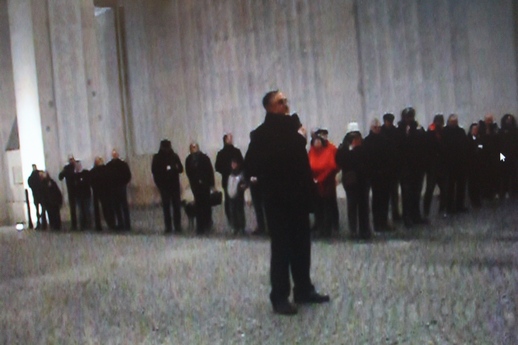
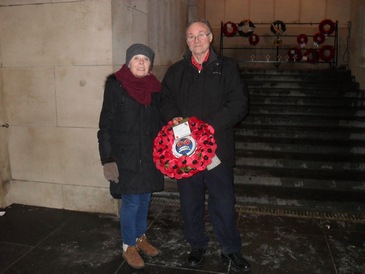
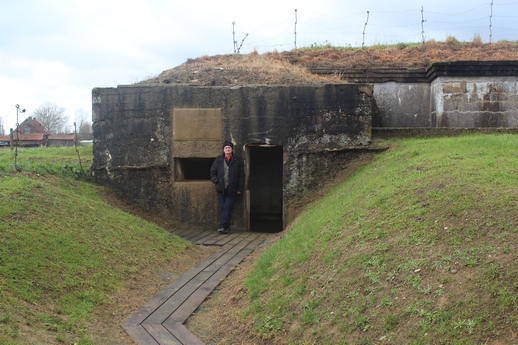
Last Month's Talk
Mike O'Brien gave us a most entertaining talk on Americans in the British forces (as opposed for example to the Canadian army). His research has been published in a new book which is reviewed here.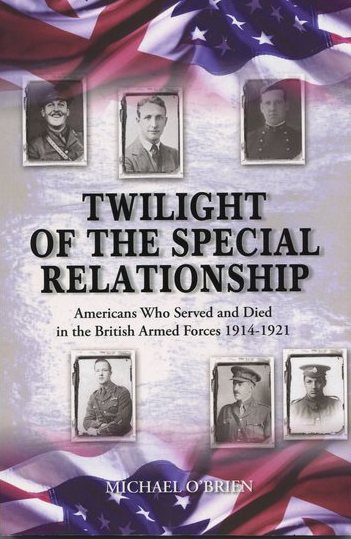
100 Years Ago
About 9.30 p.m. on Saturday, 12th January, destroyers H.M.S. Opal and Narbrough were in company Opal leading. There was a thick blizzard on at the time and a heavy following sea.
Both ships had been sailing with the light cruiser Bodicea searching for enemy minelayers in the vicinity of Scapa Flow. Due to the bad weather and the danger of swamping, the cruiser instructed the two destroyers to return to Scapa Flow. Unfortunately, both ships collided with the rocky outcrop Clett of Crura. There were 188 fatalities and the only survivor was William Sissons who had been on board Opal. At the Court of Enquiry he gave evidence as to the loss of the two vessels.
Opal struck heavily about three times and shortly after appeared to slide into deep water. Almost immediately after striking Opal was pooped by the following sea which filled up her after part and carried away her funnels and mast. After apparently sliding into deeper water her fore part broke off at the break of the forecastle and the remainder foundered in about a quarter of an hour from striking.
Directly Opal who, Sissons stated, had been sounding with a sounding machine, struck, she blew three blasts on her siren which were answered by Narbrough. Narbrough appeared to pass Opal on the port quarter, strike heavily and heel well over.
Nothing more of Narbrough was seen by the survivor. He stated that Captain and Sub-Lieutenant of Opal were on the bridge at the time of striking and after striking orders were given to abandon ship. He did not observe any boat manage to get away safely and stated that the Carley Floats were launched but owing to sea no one could remain on them.
He swam ashore and reached a ledge, with crevices, well sheltered from the wind, with about 50 yards on which to walk about. He kept himself alive with shellfish and snow, and at one time managed to scale the cliff to within a few feet of the top but fell back again.
He considered that men on deck before the midship gun-platform should have had some chance of saving themselves, but could give no information as to anyone from Narbrough.
From the board of Enquiry-Ed
Photos:
HMS Narbrough
HMS Opal
William Sissons
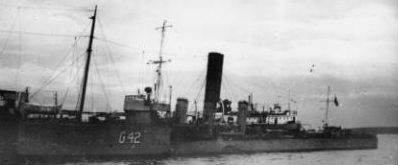
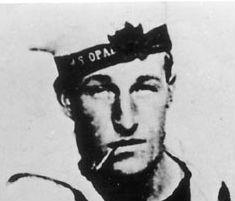
- Details
- Category: Newsletters
Chairman’s Notes
Good evening and welcome to the October meeting. Tonight we welcome Dr. Phylomena Badsey to the Branch. As well as being a speaker on the nursing aspects on the War, she is also responsible for higher education within the WFA.
100 hundred years ago the BEF had just embarked on the first assault to take the village of Passchendaele, the name and reputation of which has often been transposed as the popular title for Third Ypres. I am sure Branch members will be aware of the progress (or lack of it) and weather conditions for which the battle is synonymous.
Immediately before our meeting next month a short ceremony will be held to reflect the Remembrance weekend.
Terry Jackson, Chairman.
Last Month’s Talk
Peter Hart gave the branch an entertaining talk on the role of the RFA at Third Ypres. Previously the Corps had been out classed at Arras in what became known as ‘Bloody April’.
Later that year the RFC had evolved and awaited the challenge of the intended breakout from Ypres following the Messines Ridge mine assault on 7th June. The Corps had evolved and was determined to take on the German fighters.
The Sopworth Camel had a rotary engine with the cylinders rotating round a static crankshaft. Whilst it was a powerful engine, due to its design it had a heavy torque to the left. It had two machine guns. The SE5 had one Vickers gun on the fuselage and a Lewis gun on the top wing. It handled well in a dive.
The RFC also had numerical superioritywith 750 aircraft (330 Scouts {Fighters}) to the Germans’ 600/200. This caused the Germans to increase their formation size to offset their lack of numbers. The most well-known enemy unit was Richtofen’s Flying Circus. Following their leader’s example of painting his aircraft red, his comrades painted their craft in various colours. The RFC tended to lose more craft as they pushed over enemy lines whilst the Germans rarely entered British airspace. The British aim was to deny the enemy gain information of the overall British plan.
Unfortunately, the battle frequently took part in bad (flying) weather. As the battle progressed the RFC sent information to the artillery on the positions of enemy guns and using a ‘clock’ system could direct RFA fire onto enemy reinforcements. Some bombing raids using 25lb bombs were carried out against enemy airfields and ‘strafing’ on infantry units became more prevalent.
Dogfights became more common and ‘aces’ emerged. On 23 September James McCudden shot down the ace Voss who had 49 kills to his name. (McCudden was killed in accident in July 1918).
Our thanks to Peter for standing in at short notice and as usual, giving a lively account of The RFC at 3rd Ypres. WFA members can read a fuller account by Peter in the June/July 2017 Stand To issue to remember Passchendaele. Ed
Wyndham Lewis
IWM North
Ann and I recently visited the IWM North to see the Wyndham Lewis exhibition.
Lewis, born in Canada, was a painter of exceptional talent, but very intense. He was involved with the Vorticists at the turn of the last century.
He served as an artillery officer in the Great War. His painting A Battery Shelled is probably his most famous work. It shows observation officers watching their men being attacked by enemy gunfire (see below). It is a dramatic piece of work and is included in the exhibition.
I can recommend a visit to see the exhibition which is on until the end of the year.
Ed
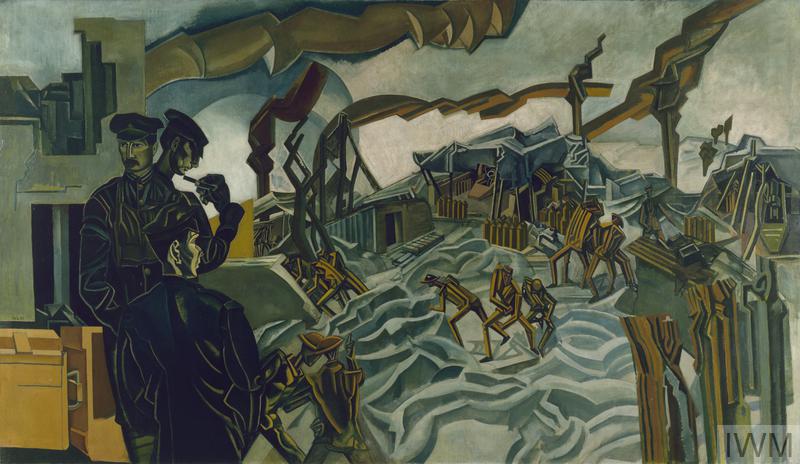
WFA Chairmen's* Conference
Gary Trown, the WFA Branch Co-ordinator has sent me the following details of the Branch Chairmans’ meeting to held next February (see below). Unfortunately, this is the same date as Ann’s birthday and we have already made alternative arrangements. It is a very good opportunity to meet other members and see how they run their branches.
I should be very grateful if a member could volunteer to attend on my behalf. Please let me know as soon as possible if you are interested”.
Terry Jackson. Chairman L&CWFA
*Chairmen can be of either gender!
Dear Terry,
I am writing to confirm the venue and dates for the Branch Chair's Conference
Venue is The Union Jack Club, Sandell Street, London SE1 8UJ (Next to Waterloo Station)
Dates - Saturday 17th February from 13.00 to Sunday 18th February 12.30
We will cover reasonable travel costs + Bed , Breakfast and Dinner for 1 delegate from each Branch. This is a chance to exchange ideas and share good practice.
Further communications will confirm joining instructions and request agenda items.
Can you confirm the name of your delegate asap
Gary Trown, Branch Co-ordinator
- Details
- Category: Newsletters
Chairman’s Notes
Good evening and welcome to the September meeting. I am pleased to inform you that I now have a full diary for the 2018 speakers. At present it is not possible to post them on the national website. In the meantime a brief résumé of the speakers and their topics are on this website.
100 Years ago the Second Army was preparing for a continuation of the assault at Ypres and early in the month an attack by 42nd and 61st Division at Hill 35 failed. During early September, Second Army was preparing for another major assault. The halt in the operations was to enable construction of roadways to bring forward artillery and ammunition. Railheads for ammunition supplies were also being built.
Last month we were enlightened by Professor Derry on the land campaign. Tonight I am pleased to welcome back Peter Hart who will be looking at the role of the RFC in the battle. Peter is a regular speaker at the Branch and he has provided us with some of the most interesting accounts of the war. Furthermore, I am deeply indebted to Peter for standing in at very short notice following the illness of the original speaker. I know we are going to be thoroughly entertained.
May I remind you that Stockport War Memorial and Art Gallery will be hosting an exhibition on the history of the Stockport TA building from 12th September until 4th October.
Terry Jackson, Chairman
Last Month’s Talk
Professor John Derry yet again held a captive audience at the Branch as he gave his reflections on Third Ypres. The battle was particularly remembered for the atrocious weather that occurred during the late summer and autumn of 1917.
The weather was exceptionally bad for the time of year and could not have been foreseen as politicians of the time would have us believe. It meant that the fragile drainage already damaged by excessive shelling was further ruined by the rain. However, the battle was not unique for heavy casualties. The 1944 Normandy campaign had a higher daily rate of attrition and the Stalingrad battle was equally intense. Unfortunately, the perceived lack of success and the underhand political reaction caused 3rd Ypres to be regarded as a failure.
There were good reasons for an assault in 1917. Ypres had been held by the British Army and was the only town of any size not in enemy hands. Germany therefore occupied virtually all of Belgium and the main industrial areas of France. Ypres also protected the channel ports which were vital if Britain was to provide a continuous presence on the Western Front. Ypres had withstood two previous assaults; the last one in 1915 saw the use of gas by the enemy, thereby confirming its intention to stop at nothing for its conquests.
In 1916, Britain was required to help the French who were engaged in a titanic struggle at Verdun. The Somme was not a choice of the British and the battle was fought over non-strategic ground in order to take the pressure off its ally.
Following the end of Verdun, the new French commander Nivelle was able to convince his government that his success there could be replicated on a larger scale at the Aisne. He was also popular with the British politicians, especially Lloyd George. Nivelle was a protestant, his mother was English and he spoke our language fluently. British forces were therefore to attack at Arras.
Unfortunately, the Germans pre-empted him by withdrawing to the Hindenburg line. Nivelle persisted in keeping to his original plan and the failure brought about mutinies. The French soldiers refused to do futile attacks, but were willing to defend their homeland to the end. The inevitable removal of Nivelle meant that any attack on the enemy would have to be carried out by the British.
This was what Haig had anticipated. As well as hoping to protect the channel ports, he was being advised by the Admiralty that the northern coast of Belgium housed the enemy submarine fleet. That was now engaged in an all-out assault on shipping as the USA had declared war on them in April. That Germany held Roulers also gave the enemy a fundamental transport base for northern Europe and its capture would seriously hamper their logistics. Furthermore, shipping losses caused by the undersea vessels were threatening the sustainability of the war in Britain. It was therefore imperative that action was necessary even before the American forces could arrive in sufficient numbers and trained to be an effective fighting force.
The BEF had been learning its lessons. Training now involved all arms co-operation. Haig had long since seen the value of tanks and aircraft, the former still developing and never available in sufficient numbers. Artillery was much improved with the use of the creeping barrage and improved ammunition providing a better scientific support. The Canadians had shown their improved tactics with the capture of Vimy Ridge at Easter. Plumer in charge of Second Army, together with his excellent Chief of Staff Harrington, masterminded the success of Messines Ridge in June. Troops were well trained and shown models of the land over which they would fight. Staff work was much improved.
Haig’s mistake, notwithstanding the on-going debate about the delay after Messines, was to give control to Gough (5th Army), who had the reputation of a ‘Thruster’. Haig had given Gough a limited aim, but Gough tried to push the attack too vigorously in very poor conditions. This led Haig to replace him with Plumer and 2nd Army. Plumer planned the assaults on the Menin Road, Polygon Wood and Broodseinde.
Although progress was made, the weather began to deteriorate. On 9th October ANZAC units attacked towards Passchendaele. The village was on one of the highest points of the main ridge. The artillery barrage failed, many shells failing to explode in the waterlogged ground. On 13th October the attack was postponed until the weather improved. The weather began to improve and following a substantial bombardment the Canadians attacked on 26th October. Unfortunately the rain restarted.
After several days of reasonable weather, on 30th October the Canadians attacked the southern edge of the ridge. .Unfortunately the weather turned again restricting progress. An attack on 6th November enabled the Canadians to take the village. A final assault was made on 10th November enabled the high points of the ridge to be taken.
Third Ypres became the focus in future years of the anti-war brigade as an example of the poor performance of the British Army and its commanders. Lloyd George tried to indicate that Haig had authorised the assault despite the bad weather. Haig did make mistakes, After Messines he handed the assault to Gough and his Fifth Army. He was regarded as a thruster. Plumer had asked for a delay to refit and recover, but Haig thought Gough could push on. As it happened Gough also requested a delay to prepare, which turned out to be longer than that proposed by Plumer.
Much has been made of the continuation of the attacks in bad weather. Lloyd George cited this, but in fact the weather was abnormally wet for the time of year. Unfortunately, although many of the attacks commenced in relatively acceptable conditions, the weather frequently suffered a bad spell. Furthermore as the terrain was over a series of ridges, it would have been impossible and suicidal to dig in nearer to the enemy highpoint and being overlooked by their artillery. Passchendale had to be taken and secured to create a defensible line.
British casualties were in the region of 370,000 and it is estimated the Germans suffered a similar number. Although the front had been pushed out, Roulers had not been taken and the Flemish coast was still in enemy hands. Although Russia was now out of the war, it did not offset the prospect of a much greater influx of USA soldiers in 1918. Germany was short of reinforcements and the British were required to reduce the size of brigades from 12 to 9 battalions. However, Lloyd George kept fighting reinforcements from Haig by including a huge number of non-combatants in the figures he presented to Parliament. Fundamentally, the British assault disguised the effect of the mutinies in the French Army. Furthermore, the dire straits in which Germany found itself forced Ludendorff to embark on a reckless gamble in the Spring Offensive, which was ultimately to prove disastrous.
Yet another first class and entertaining talk by Professor Derry. Ed
100 Years Ago
Ecaterina Teodoroiu (1894-1917) was a Romanian soldier who fought against German forces during the First World War.
Teodoroiu spent her teenage years as a member of the Romanian Scouts and studied at the Girl's School in Budapest. She planned to become a school teacher, however when Romania entered World War I on the Allied side in 1916 she instead decided to serve as a nurse with the Scouts. Inspired by the patriotism of the wounded soldiers that she treated and the death of her brother in action, she decided to enlist as a soldier.
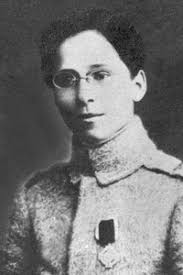
Although she had to apply several times before the Romanian army eventually accepted her, Teodoroiu saw combat in October 1916 at the first Battle of Jiu as part of General Ion Dragalina's 1st Army. Some accounts say that Teodoroiu played a key part in this battle by rallying soldiers defending a bridge. Despite initially repulsing the German offensive, the 1st Army was forced back and during the retreat Teodoroiu was captured. However she managed to escape, killing at least two German soldiers in the process while sustaining only a leg wound in return.
She continued to serve in the army, however in November 1916 she was seriously wounded by a mortar strike and had to be hospitalised. She received the Military Virtue Medal, 1st Class, for her bravery and on her return to duty was promoted to Sublocotenent (Second Lieutenant) and given command of a 25-man platoon.
Teodoroiu was killed on September 3rd 1917, during the Battle of Marasesti, the last battle fought between Romania and Germany in the war. She was hit in the chest by a burst of machine gun fire as she led her platoon against a unit of entrenched Germans. Her last words as she died were to call out "Forward, men, I'm still with you!".
Teodoroiu was buried in Targu Jiu where her grave is honoured by a monument. She is regarded as a heroine of Romania.
- Details
- Category: Newsletters
Chairman’s Notes
Good Evening and welcome to the August meeting. We have received a thank you acknowledgement from Colin Wagstaff, Chairman of the WFA, for our donation towards a board at the Butte De Warlencourt. This will mean that our Branch will be exclusively mentioned on one of the notice boards to be erected on the site.
I am pleased to be able to welcome back the Branch’s favourite speaker, Professor John Derry. Our regular audience will be anticipating another enthralling talk, this time on 3rd Ypres. Following cross references from members who also belong to other groups, John now makes at least three other visits to the locality to talk to the WI and church organisations. As usual, after John speaks, he is invited to another group represented in the audience. I do not need to say you will be fully enlightened by the end of the evening.
Terry Jackson, Chairman.
Last Month’s Talk
Kate Wills gave an entertaining account of how music and musicians were affected by the outbreak of the war.
There were many German immigrants and their descendants then living in the country. Gustav Holst was from a German background. He tried to enlist in the British army, but was deemed unfit. He was involved with the YMCA orchestra in Salonika during the demobilisation period.
Basil Cameron Hindenberg was the son of a German immigrant family. After dropping the German name he was to eventually become involved in organising the Prom concerts after the war.
Lena Ashwell was the daughter of a naval commander and was born on board ship. She studied music, but later became an actress. She was married but divorced after an affair with an actor, before again marrying this time to a Royal obstetrician. She became involved with the YWCA and despite difficulties took an all-male group to entertain the troops.
When World War I broke out, the composer Elgar signed up as a special constable in the local police and later joined the Hampstead Volunteer Reserve of the army. He composed patriotic works. The earlier Land of Hope and Glory, already popular, became still more so.
Fritz Kreisler was born in Vienna and became a famous violin virtuoso. He briefly served in the Austrian army, and was discharged after being wounded. He moved to the USA. He retuned there after the outbreak of the Second World War and took citizenship.
The most famous British song from the war was It’s a long way to Tipperary written by Jack Judge. It was said to have been written as a bet when he was performing in Stalybridge. Judge’s grandparents were from Tipperary and the song was soon adopted by the Tommies. There is a sculpture of the composer in Stalybridge.
Kate provided many other examples of various musicians from both sides who either wrote or performed in relation to the conflict.
A really fascinating in depth account of the impact of the war on the music scene. Ed
100 Years Ago
The Capture of Westhoek (10 August 1917) took place on the Gheluvelt Plateau during the Third Battle of Ypres (31 July–10 November1917). British Fifth Army attacked the Gheluvelt Plateau at the Battle of Pilckem Ridge (31 July – 2 August), but the German 4th Army had fortified its positions in the Ypres Salient since the Second Battle of Ypres. The British reached the first objective in the south and the second objective on the northern flank, but lost some ground to German counter-attacks. Another attack on 2 August was postponed due to torrential rain from the afternoon of 31 July until 5 August.
The ground had been churned by artillery-fire and became a sea of mud, flooded shell craters, fallen trees and barbed wire. After several postponements the next attack was set for 10 August. British artillery fired a preparatory bombardment from Polygon Wood to Langemarck for the main attack on 14 August, but the German guns concentrated on the Gheluvelt Plateau. British counter-battery artillery was hampered by low cloud and rain, which made air observation extremely difficult and shells were wasted on empty gun emplacements. The fresh 25th and 18th divisions took over by 4 August, but the front-line troops had to be relieved every 48 hours, which exhausted all of the infantry by 10 August. The German 52nd Reserve Division had not been relieved after 31 July and the 54th Division took over in the north by 4 August and were also exhausted by 10 August.
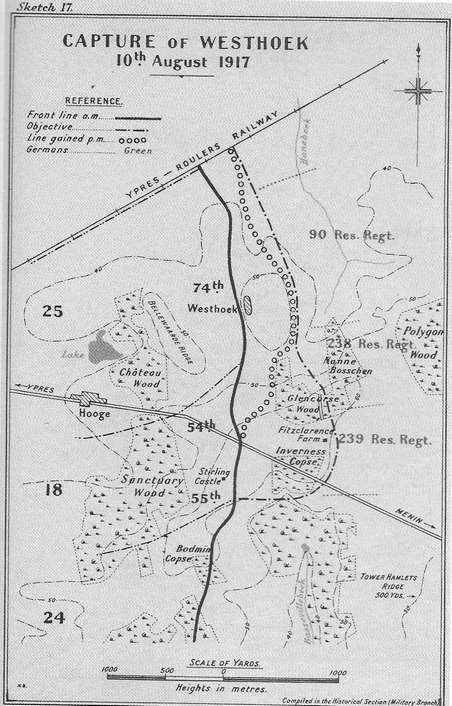
The 18th Division attacked on the right and some troops quickly reached their objectives but German artillery began a SOS Barrage at 6.00 a.m., from Stirling Castle to Westhoek. This isolated the foremost infantry in the open north of Inverness Copse and in Glencorse Wood. German troops began immediate counter-attacks and around 7:00 p.m., fresh German infantry advanced behind a smokescreen. By nightfall the copse and all but the north-west corner of Glencorse Wood had been recaptured. The 74th Brigade of the 25th Division on the left flank advanced quickly and reached its objectives by 5:30 a.m. The Germans in Westhoek were rushed, but on the right flank, sniping and attacks by German aircraft caused an increasing number of casualties.
The 25th Division held its gains around Westhoek but lost 158 men killed, 1,033 wounded and more than 100 missing. The defeat of the 18th Division at Inverness Copse, Fitzclarence Farm and Glencorse Wood allowed German snipers and machine-gunners to fire into the 25th Division area, particularly on the right flank. The Germans counter-attacked several times and on into the night, but communication by SOS rockets, daylight lamps, carrier pigeons and runners, enabled the British artillery accurately to bombard German troops in their counter-attack assembly positions. The appalling weather and costly defeats began a slump in British infantry morale; excessive casualties and the replacement shortage concerned the German commanders.
Ed
Stockport’s Worst Day
On July 31, 1917, 600 local men and 20 officers went over the top in driving rain near Ypres, Belgium. The push was part of a 20-mile wide offensive designed to break through enemy lines and target German submarines.
It was to be the worst day of the entire war for Stockport’s men.
Alan Kennedy, Chair of the Cheshire Regiment’s Stockport Association, visits the battlefield each summer with other members.
"These lads were weekend warriors," he says. "They were pals, they lived in the same street, went to the same schools, attended the same youth clubs and were told ‘it‘ll be done by Christmas’.
"So they went off singing and dancing to absolute attrition.
"They died through heavy artillery, and the fact the water tables had been destroyed - so as they were hit they sank into the mud.
"If they weren’t hit and killed they drowned."
Stockport’s soldiers took four hours to march three miles through the mud, and when they reached their target - exactly on time - just 57 men and two officers were still standing. More than 100 soldiers were dead, and hundreds more lay wounded on the battlefield.
For those left behind at home, the loss of so many men from such a small area was devastating.
Local war historian John Hartley, who has been researching the local men who died in the world wars, is investigating the true impact of the war on Stockport - and believes news travelled fast.
"It was Stockport’s worst day of the war, and people in the town would have known very quickly," he says. "There wasn‘t the restriction on reporting that surrounds military conflicts now.
"The men lived very close to the Armoury on Greek St - they worked in the cotton mills and hat works that surrounded it. It was a very close community of people.
He adds: "That must have had a terrible impact of grief in this small area of terraced houses in the town centre. There are stories there to be told."
From the Manchester Evening News
There are two entries in the Official History for that day.
Extract from the Official History 1917:
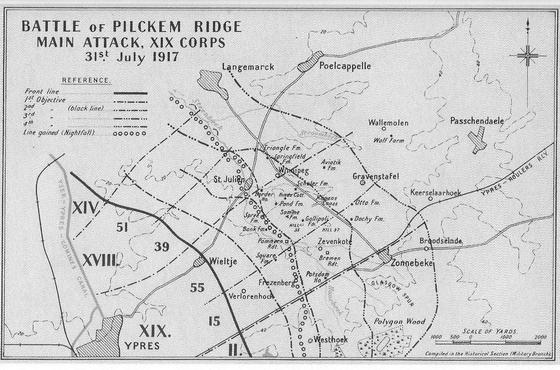
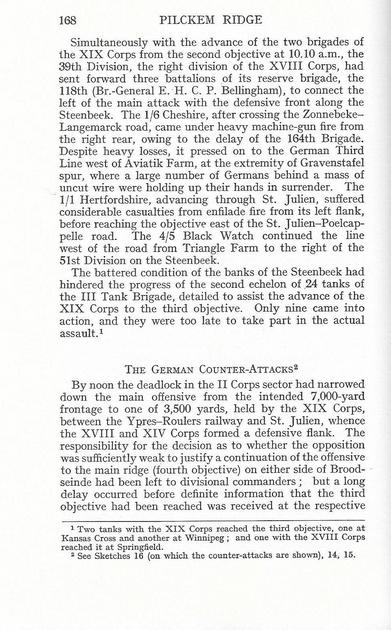
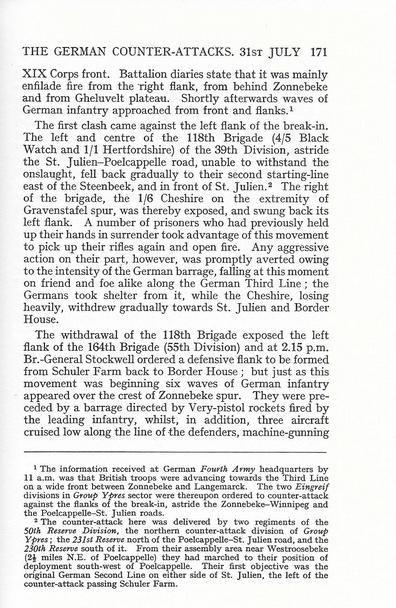
St Julien Memorial Service
On Sunday 6th August, Ann and I represented the WFA to commemorate the Battle of St Julien (31st July 1917). The forefathers of our hosts at the TA who were 6 Battalion Cheshire Regiment attacked on the opening day of Third Ypres. It became known as Stockport’s worst day.
The well attended service was led by Canon Elaine Chegwin Hall and the Sermon was given by Rt. Revd. Libby Lane, Bishop of Stockport. Afterwards we joined the dignitaries and guests at the Armoury for light refreshments.
Terry Jackson, Chairman Lancs & Ches WFA
